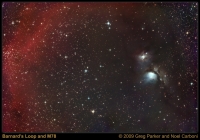I still find it very strange that this large, bright reflection nebula does not have a “popular” name. To me it look like a cauldron of boiling liquid oxygen, so I shall call it “the Cauldron”. M78 is a beautiful reflection nebula in Orion, and you can see from the accompanying image that it lies very close to Barnard’s Loop. As you will know, Barnard’s Loop is faint, so to get this showing up in the image it is a good idea to collect some narrowband H-alpha data. The reflection nebula although appearing to be narrowband blue is in fact broadband blue (due to scattering of a broad band of short wavelengths of light) – so M78 doe not benefit from narrowband filters. However, you can see that the whole area is also permeated by dark dust clouds, and to get these showing up at all in your image you need lots of exposure time and long subs. This image is a composite of H-alpha data taken with the Sky90/M25C, RGB data of M78 alone taken with the original Hyperstar and SXV-H9C, and finally the main part of the template is Hyperstar III RGB data with its 2.41 x 1.6 degree field of view. You can see that by framing the subject (M78) off to the right of the FOV you can bring in the edge of Barnard’s Loop over to the left which makes for a more interesting image.
Usual formula for a nice picture – lots of subs – long exposure time for each sub – and add some good deep H-alpha data to capture the faint Barnard’s Loop. At least we still have long nights to do this stuff, soon the clocks will go forward and it will be back to no imaging before 9:00 p.m. 🙁
Clear skies until our March edition of IOM.


